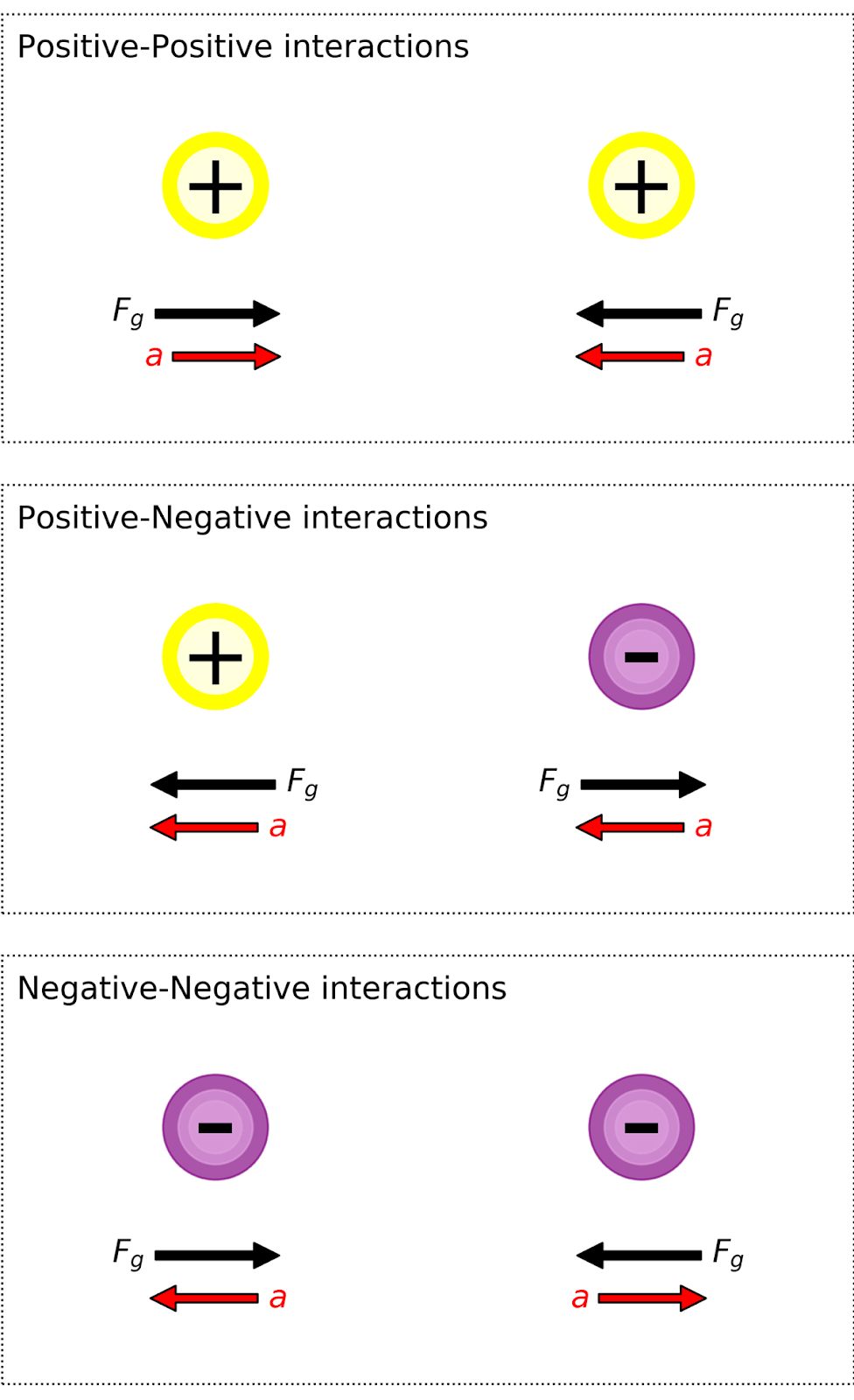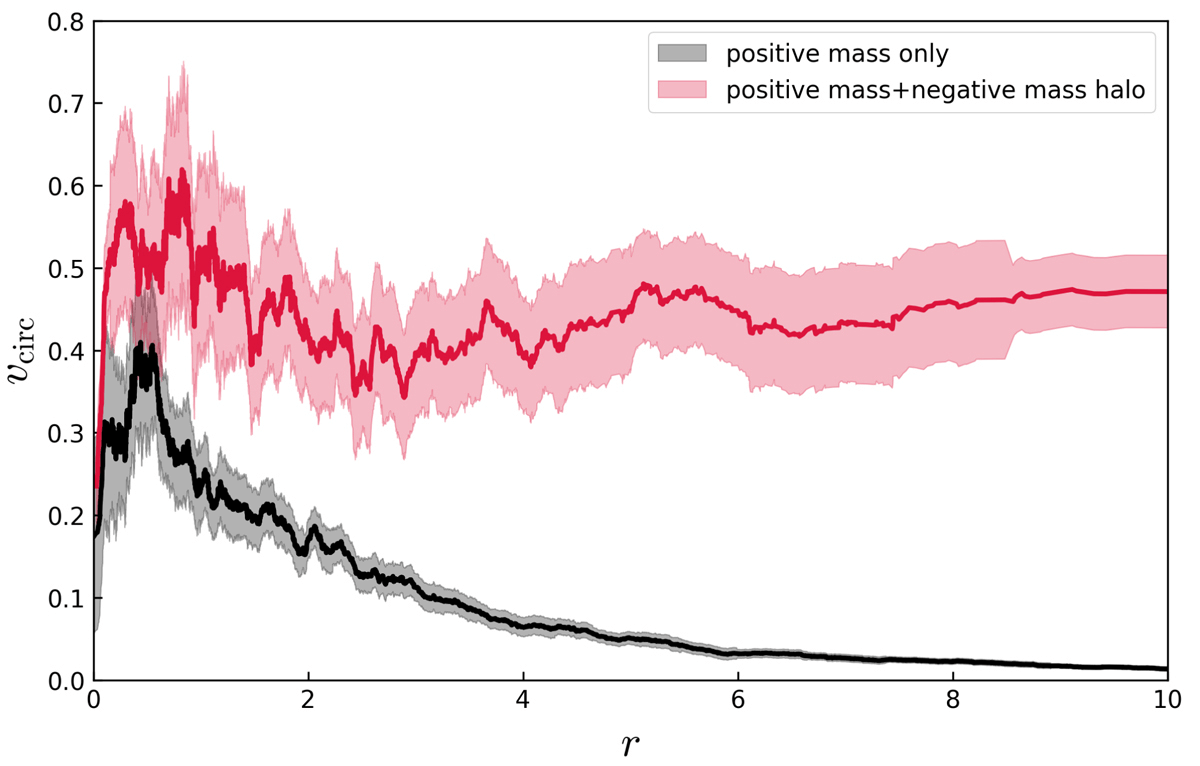TUESDAY, 3 NOVEMBER 2020
If I were to tell you that some things in the Universe have a negative charge, you would not be very surprised. After all, regardless of how much time you spend rubbing your hair with a balloon, you yourself will still be composed of almost exactly half negative charge.However, if I were to tell you that something has a negative mass, you would doubtless be more sceptical. After all, there’s nothing in the Standard Model, our representation of all the essential subatomic particles in the known Universe, which has a negative mass. It is an idea nobody talks about seriously, which is perhaps strange given the similarities between the forces of gravity and electrostatics,such as the fact that both forces follow an inverse-square law. Suspending our disbelief somewhat, we might ask: what if negative mass did exist? This is precisely the question I begin to answer here, and as it turns out, the concept might be the key to understanding some of the biggest problems in modern physics - including that of mysterious ‘dark matter’.
Let’s think about gravity. You might think that negative masses would behave just like negative charges, i.e. that positive and negative masses attract one another, whilst mass of the same sign repels - but of course, two positive masses attract, so we cannot analogise the signs in the same way. In fact, the behaviour is more like what is shown in Figure 1. The gravitational field around a positive mass is directed towards it, but flipping the signs in Newton’s law of gravitation shows that the field is directed away from negative masses - they repel other masses. (Side note - it doesn’t matter whether another mass in its field is positive or negative, negative masses repel everything. This follows from the equivalence of gravitational and inertial mass, assuming that still works for negative masses.) So, if we put two negative masses next to each other, they will repel.
If two positives attract and two negatives repel, what if we put a positive mass next to a negative mass? They will try to push each other away, but given the negative inertia of the negative mass, it will respond to the repulsive gravitational force by moving towards the positive mass. So the positive will run away from the negative, and the negative will chase after it! In principle, if the masses have the same magnitude, they will each accelerate together in the same direction, forever, despite both starting from rest.
 Figure 1: The possible ways masses of different signs can interact gravitationally. Black arrows show the gravitational forces and red arrows the resulting accelerations (Farnes, 2017). Image used with permission from Creative Commons licence from https://www.aanda.org/articles/aa/full_html/2018/12/aa32898-18/aa32898-18.html
Figure 1: The possible ways masses of different signs can interact gravitationally. Black arrows show the gravitational forces and red arrows the resulting accelerations (Farnes, 2017). Image used with permission from Creative Commons licence from https://www.aanda.org/articles/aa/full_html/2018/12/aa32898-18/aa32898-18.htmlWe can devise situations which are weirder still. In Richard H. Price’s delightful paper, “Negative mass can be positively amusing” (Price, 1993), he considers suspending a positive mass in midair, by placing an equal and “opposite” negative mass vertically above it, and connecting the two with a taut string where the tension is of the same magnitude as the gravitational forces experienced by the two masses. Now for the positive mass, gravity is pulling it down, and the tension in the string is pulling it up by the same amount . For the negative mass, the string is pulling it down, but gravity is pulling it up (its acceleration would be down towards the Earth, but because F=ma, the force is upwards), again by the same amount. Since the tensions and masses are equal, both masses must be in equilibrium - the whole thing just floats there, like an eerie sentinel. If we cut the string, the tension forces disappear, and the only force left is gravity, which causes both masses to accelerate downwards. The floating sentinel falls to the floor!
I hope that by this stage I have convinced you that negative mass is not only an interesting idea, but also that it stubbornly follows the laws of physics just as well as positive mass. The natural question is then: could our Universe actually contain negative mass?
Every now and then, the media will spit out a dramatic and definitive headline such as “Physicists observe negative mass”, when a paper such as that of Khamehchi et al. 2017 is published. The literature is not devoid of experiments which have demonstrated negative effective mass, which is a concept that can arise when describing the behaviour of quasiparticles in a material. Although curious, that isn’t exactly what we’re looking for - the “negative masses” in Khamehchi’s paper are made out of rubidium atoms, which have a definite positive mass. So are there any honest-to-goodness negative mass fundamental particles in the Universe? Although of course never observed, some speculative theories suggest that the answer might be yes. And what’s more, they might even hold the answers to some of the most burning questions in physics.
Physics’ greatest embarrassment at the moment is that 95% of what it seeks to describe is totally unaccounted for by its current theories. There is, as yet, no explanation for the flatness of galaxy rotation curves, or for the acceleration of the expansion of the Universe. 95% of the Universe is a lot, but Dr Jamie Farnes (of the Other Place) may have come up with a way to account for it all, with one elegant idea (Farnes, 2018). Perhaps you can guess what it is.
Farnes ran a set of N-body simulations - brute-force representations of a large number of particles interacting - at a galactic scale, containing a mixture of positive and negative masses (his code is available online here), and the results are suspiciously promising. On running the simulations, Farnes saw that the negative masses began to spread out into a halo, and the resulting galaxy rotation curve was much flatter (red) than simulations ran with just positive mass present (black).
 Figure 2: Simulated galaxy rotation curves, with just positive mass present (black) and with both positive and negative mass present (red) (Farnes, 2017). Image used with permission from Creative Commons license from https://www.aanda.org/articles/aa/full_html/2018/12/aa32898-18/aa32898-18.html
Figure 2: Simulated galaxy rotation curves, with just positive mass present (black) and with both positive and negative mass present (red) (Farnes, 2017). Image used with permission from Creative Commons license from https://www.aanda.org/articles/aa/full_html/2018/12/aa32898-18/aa32898-18.htmlNegative mass is an uncomfortable idea to get one’s head around. It exhibits highly counter-intuitive behaviour, yet somehow it violates no laws of physics. However, this is more than just a mathematical curiosity, a quirky belief supported by its surprising usefulness in answering active research questions. I think that negative mass has the potential to explain a wide array of phenomena that are so stubbornly opaque to modern physicists. This is definitely a space to watch.
Alex Byrne is a second year Natural Sciences undergraduate at St Catharine’s College
References:
Farnes (2017). A unifying theory of dark energy and dark matter: Negative masses and matter creation within a modified ΛCDM framework. Astronomy & Astrophysics, 620 A92
Khamehchi et al. (2017). Negative Mass Hydrodynamics in a Spin-Orbit-Coupled Bose-Einstein Condensate. Phys. Rev. Lett., 118, 155301
Price (1993). Negative mass can be positively amusing. American Journal of Physics, 61, 216
